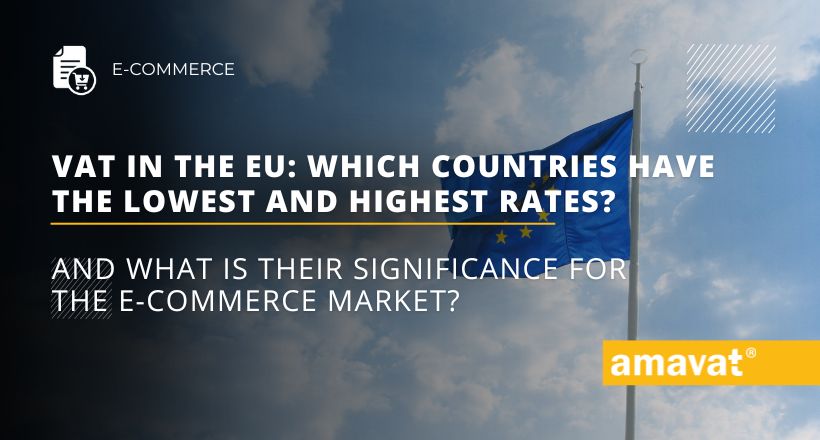VAT in the EU: Which countries have the lowest and highest rates and what is their significance for the e-commerce market?
Value Added Tax (VAT) plays a crucial role in the tax systems of European Union (EU) countries, influencing the prices of goods and services. For e-commerce sellers, understanding and tracking VAT rates is particularly important as it can significantly impact pricing strategy and competitiveness in the international market. In this article, you will learn about the highest and lowest VAT rates in individual EU countries, along with key aspects related to this tax for e-commerce businesses.
Highest VAT rates in Europe
Leading among EU countries with the highest VAT rates are Hungary, applying a standard rate of 27%. This is the highest rate across the entire European Union. Following closely are Croatia, Denmark, and Sweden with a rate of 25%. The high VAT rates in these countries serve to bolster state budgets but can also lead to higher consumer prices.
For e-commerce sellers, this means products offered in these countries may be more expensive compared to those sold in countries with lower VAT rates.
For more detailed information and a table of VAT rates across different European countries, we invite you to read our article: VAT rates in the EU in 2024: Overview and analysis.
Lowest VAT rates in Europe
Luxembourg applies the lowest VAT rate in the EU at 17%. Other countries with low rates include Malta (18%), Cyprus, Germany, and Romania (all at 19%).
However, looking broader across Europe, Switzerland has the lowest VAT rate at just 8.1%, significantly below the EU minimum VAT rate.
Low VAT rates in these countries can stimulate local economies by increasing consumer purchasing power. E-commerce sellers can leverage these lower rates to attract customers from outside these countries by offering competitive prices compared to countries with higher VAT rates.
Average VAT rate in the EU
The average standard VAT rate in the EU is 21.6%. This is considerably higher than the minimum required VAT rate set by EU regulations, reflecting member states’ tendency to maintain relatively high consumption taxes. For e-commerce sellers, this means being aware of both national and EU VAT regulations to effectively plan pricing strategies.
VAT in European OECD countries outside the EU
Among the five European OECD countries that are not EU members — Iceland, Norway, Switzerland, Turkey, and the United Kingdom — only Switzerland applies a standard VAT rate below the EU’s minimum level, at 8.1%. The other countries have VAT rates above this level, which can impact their competitiveness in the international market.
In contrast, the average state and local sales tax rate in the United States was only 6.6% in 2023. This low tax rate makes products sold in the USA potentially more competitive in terms of pricing compared to products from Europe, where VAT rates are significantly higher.
Changes in VAT rates in recent years
In recent years, several EU countries have adjusted their VAT rates. Estonia increased its standard rate from 20% to 22%, while Luxembourg, though still maintaining the lowest rate in the EU, raised it from 16% to 17%.
Switzerland, despite not being an EU member, increased its VAT rate from 7.7% to 8.1%, which still remains well below the EU average.
Meanwhile, in response to rising living costs and to support consumers, the Spanish government has announced the extension of the zero VAT rate on essential food items until September 30, 2024. You can read more about this in our article.
These changes indicate that countries continually adjust their tax policies to evolving economic conditions.
Impact of VAT rates on the e-commerce market
VAT rates directly impact the prices of goods and services offered in the e-commerce market. High VAT rates can lead to higher prices, potentially discouraging online purchases. Sellers must account for these differences, especially when operating in international markets where consumers are sensitive to pricing. Even slight variations can influence consumer purchasing decisions. Therefore, e-commerce sellers should carefully analyze VAT rates in countries where they sell and adjust their pricing strategies accordingly.
Reduced VAT rates and exemptions aim to promote specific sectors of the economy, such as tourism or book sales, making products and services from these sectors more affordable for a broader audience. However, preferential VAT rates can also lead to administrative complexities and increased compliance costs.
Recommendations for e-commerce sellers – VAT in the EU
E-commerce sellers should stay updated on current VAT rates and changes to effectively manage their operations. Considering automation for VAT calculation processes can greatly simplify international sales management.
Additionally, investing in education and training for their teams ensures awareness and understanding of VAT complexities. Knowledge of local and international tax regulations is crucial for avoiding misunderstandings and errors.
Another important recommendation is to collaborate with tax experts or advisory services. VAT specialists can help interpret complex regulations, advise on tax optimization, and represent the company in tax audits: Contact us – amavat®.
Summary
Understanding VAT rates across different EU countries and their impact on the e-commerce market is crucial for effective sales management. High VAT rates can increase operational costs and affect pricing, while low rates may attract more consumers. Monitoring VAT policy changes and adapting sales strategies can help e-commerce sellers compete effectively in international markets. Ultimately, the ability to adapt to varying VAT rates can become a key element of success in the global e-commerce market.





